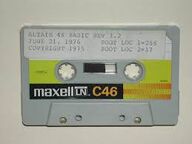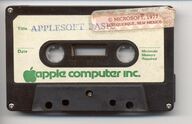
Cassette of 4K BASIC adapted by Micro-Soft for the Altair 8800.
The Compact Cassette or Musicassette (MC), also commonly called the tape cassette,[1] cassette tape, audio cassette, or simply cassette, is an analog magnetic tape recording format developed by a team led by Lou Ottens at Royal Philips in Hasselt, Belgium. It was introduced in September 1963 for audio recording and playback. It was also a popular data storage medium for early microcomputers. Compact Cassettes can be obtained with existing content as a pre-recorded cassette, or as a fully-recordable "blank" cassette. Both forms are reversible by the user.[2]
Specifications[]
Compact Cassettes contain two miniature spools, between which the magnetically coated, polyester-type plastic film (magnetic tape) is passed and wound.[3] These spools and their attendant parts are held inside a protective plastic shell which is 4 by 2.5 by 0.5 inches (10 cm × 6.3 cm × 1.3 cm) at its largest dimensions. The tape itself is commonly referred to as "eighth-inch" tape, supposedly 1⁄8 inch (3.17 mm) wide, but it is slightly larger: 0.15 inches (3.81 mm).[4] Two stereo pairs of tracks (four total) or two monaural audio tracks are available on the tape; one stereo pair or one monophonic track is played or recorded when the tape is moving in one direction and the second (pair) when moving in the other direction. This reversal is achieved either by flipping the cassette, or by the reversal of tape movement ("auto-reverse") when the mechanism detects that the tape has come to an end.[5]
History[]
Compact cassette technology was originally designed for dictation machines, but improvements in fidelity led to it supplanting stereo 8-track cartridges and reel-to-reel tape recordings in most non-professional applications.[6] Its uses ranged from portable audio to home recording. The first monaural cassette player designed for use in car dashboards was introduced in 1968. From the early 1970s to the mid-2000s, the cassette was one of the two most common formats for prerecorded music, first alongside the LP record and later the compact disc (CD).[7]
Data recording[]
In November 1975, Byte magazine held a symposium in Kansas City, Missouri to establish a standardized method of recording data from microcomputers onto readily available audiocassettes. Data was modulated (like a modem) into an audio signal that could be transmitted to the tape recorder. This method became the Kansas City standard, also called the Byte standard, which initially operated at 300 baud, with faster rates being implemented later.[8]
Microsoft[]

Cassette case insert of Microsoft Typing Tutor.
The first line of products from Microsoft (then known as "Micro-Soft") started with its own implementation of BASIC, adapted by Bill Gates and Paul Allen for the Altair 8800 in 1975. It was made available on paper tape, or cassette tape for systems that had such an interface. Microsoft licensed its BASIC to run on early home computers, including the Apple II Plus, Commodore 128, and TRS-80, which all supported cassette tape storage at the time.[9] Cassette tapes were eventually replaced by faster floppy disks as the dominant form of data storage for personal computers.[10]
References[]
- ↑ "Norelco Carry Corder 150 operating manual". Philips USA. 1971.
- ↑ "Learn about Tabs-In or Tabs-Out shells and leaders". Archived from the original on 9 August 2017. Retrieved 9 August 2017.
- ↑ Brian, Marshall (April 2000). "How Tape Recorders Work". HowStuffWorks. Retrieved 10 October 2015.
- ↑ "D NORMAL-BIAS AUDIO TAPES" (spec sheet). TDK. Retrieved 4 April 2019.
- ↑ "Part 7: Cassette for commercial tape records and domestic use". International standard IEC 60094-7: Magnetic tape sound recording and reproducing systems. International Electrotechnical Commission, Geneva.
- ↑ Marvin Camras, ed. (1985). Magnetic Tape Recording. Van Nostrand Reinhold. ISBN 978-0-442-21774-7.
- ↑ Eric D. Daniel; C. Dennis Mee; Mark H. Clark (1999). Magnetic Recording: The First 100 Years. The Institute of Electrical and Electronics Engineers. ISBN 978-0-7803-4709-0.
- ↑ The Kansas City Standard by Mark VandeWettering, Brainwagon. 2011-07-22.
- ↑ Bill Gates & Paul Allen Talk: Check out the ultimate buddy act in business history by Brent Schlender and Henry Goldblatt, CNN Money. 1995-10-02.
- ↑ Floppy disk history: The evolution of personal computing by Steven Vaughan-Nichols, Hewlett Packard Enterprise. 2017-03-17.
External links[]
- Project C-90 an ultimate audiotape guide
- Tapedeck.org analog audio tape cassette nostalgia
- Compact Cassette at Audiotools
- Compact Cassette at Wikimedia Commons
- Cassette tape at Wikipedia
|
Wikipedia (article: Cassette tape )
|


